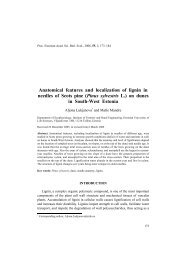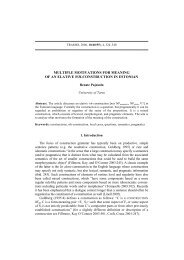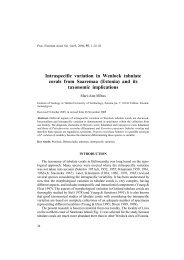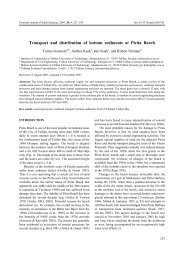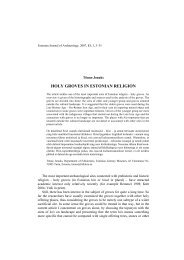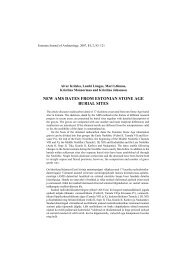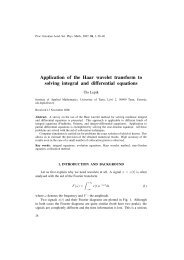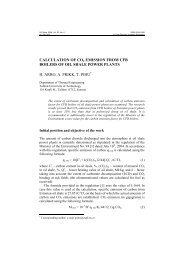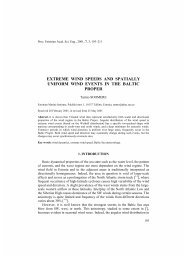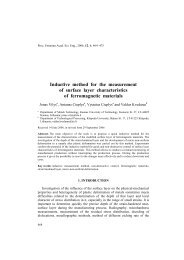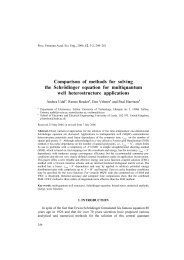Dynamic coefficients in impact mechanics
Dynamic coefficients in impact mechanics
Dynamic coefficients in impact mechanics
Create successful ePaper yourself
Turn your PDF publications into a flip-book with our unique Google optimized e-Paper software.
velocity restitution, k , and the dynamic friction coefficient, f . The method and<br />
test equipment proposed above permit the estimation of the <strong>coefficients</strong><br />
experimentally. Energy, absorbed by the target material, gives <strong>in</strong>formation about<br />
the two-body <strong>in</strong>teraction process. Moreover, tests allow simulation of s<strong>in</strong>gle or<br />
multi-<strong>impact</strong>s of controlled energy. The <strong>in</strong>itial stages of the erosion damage can<br />
be exam<strong>in</strong>ed.<br />
ACKNOWLEDGEMENTS<br />
The authors would like to express their gratitude to MSc. O. Volobujeva for<br />
her assistance by obta<strong>in</strong><strong>in</strong>g the SEM micrographs, Dr. J. Pirso for supply<strong>in</strong>g the<br />
test specimens and the DAAD Foundation, Germany, for fund<strong>in</strong>g a fellowship<br />
for this study. This research was also supported by the Estonian Science<br />
Foundation (grants Nos. 6163 and 6660).<br />
REFERENCES<br />
1. Mac Sithigh, G. P. Rigid body <strong>impact</strong> with friction – various approaches compared. In Impact<br />
Mechanics: Experiment, Theory and Calculation. ASME-AMD, NY, 1995.<br />
2. Brach, R. M. Impact dynamics with application to solid particle erosion. Int. J. Impact Eng.,<br />
1988, 7, 37–53.<br />
3. Brach, R. M. Formulation of rigid body <strong>impact</strong> problems us<strong>in</strong>g generalized <strong>coefficients</strong>. Int. J.<br />
Eng. Sci., 1998, 36, 61–71.<br />
4. Stronge, W. J. Swerve dur<strong>in</strong>g three-dimensional <strong>impact</strong> of rough bodies. J. Appl. Mech., 1994,<br />
61, 605–611.<br />
5. Schade, K.-P. and Hädrich, T. Investigation of <strong>in</strong>fluence of wall roughness on particle–wall<br />
collision. In Proc. Third International Conference on Multiphase Flow ICMF’98. Lyon,<br />
1998, 1–8.<br />
6. Petrak, D. Development <strong>in</strong> fiber-optical spatial filter velocimetry. In Proc. 2-nd International<br />
Conference on Multiphase Flow. Kyoto, 1995, Vol. 1, 9–13.<br />
7. Schade, K.-P., Erdmann, H.-J. and Petrak, D. Experimental <strong>in</strong>vestigations of the particle–wall<br />
collision under particular consideration of the wall roughness. Fluids Eng. Div., ASME,<br />
NY, 1996, 236, 759–766.<br />
8. Hussa<strong>in</strong>ova, I., Kubarsepp, J. and Shcheglov, I. Investigation of <strong>impact</strong> of solid particles aga<strong>in</strong>st<br />
hardmetal and cermet targets. Tribol. Int., 1999, 32, 337–344.<br />
9. Hussa<strong>in</strong>ova, I., Kubarsepp, J. and Pirso, J. Mechanical properties and features of erosion of<br />
cermets. Wear, 2001, 250, 818–825.<br />
10. Sundararajan, G. The energy absorbed dur<strong>in</strong>g the oblique <strong>impact</strong> of a hard ball aga<strong>in</strong>st ductile<br />
target materials. Int. J. Impact Eng., 1990, 9, 343–358.<br />
11. Hussa<strong>in</strong>ova, I. Microstructure and erosive wear <strong>in</strong> ceramic-based composites. Wear, 2005, 258,<br />
357–365.<br />
38



